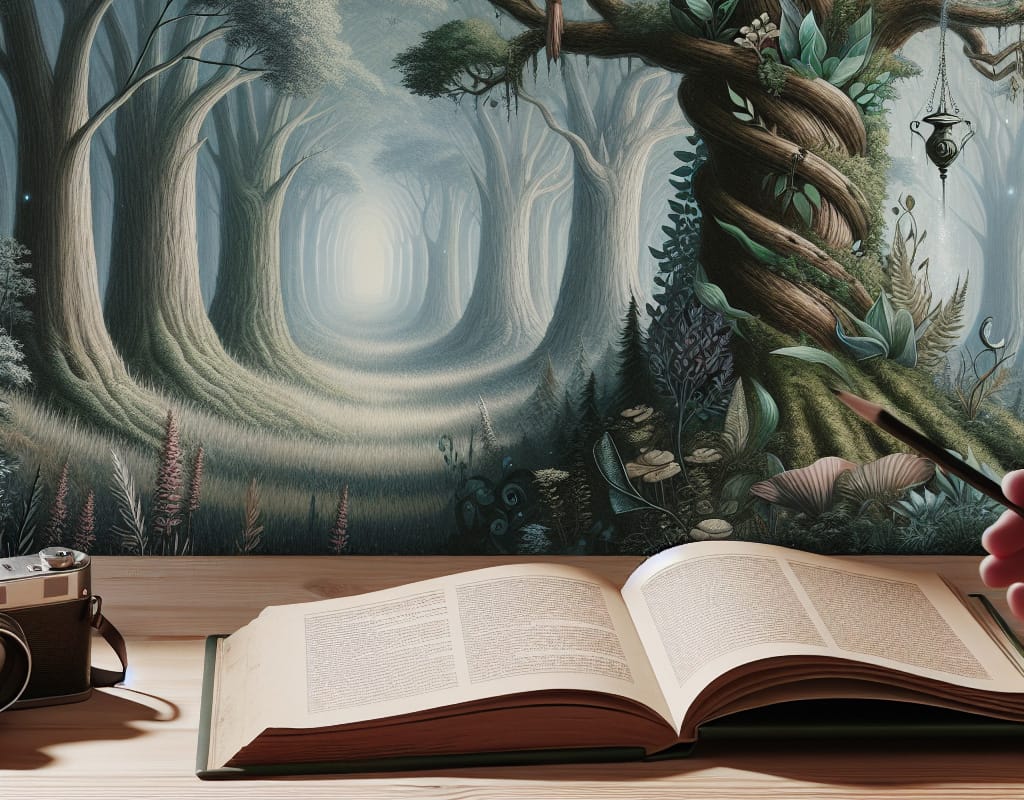The Whispering Leaves: Exploring the Profound Significance of Enchanted Forests and Magical Trees in Children's Fantasy Literature
Delve deep into the forest of imagination where enchanted trees and magical groves form the bedrock of children's fantasy literature. We explore how these ancient symbols cultivate a love for storytelling and respect for nature among young readers.

In the rich tapestry of children's literature, nothing is more quintessential than the mystique of the enchanted forest and its magical trees. These verdant realms serve as the playground for the imagination, fertile ground for life lessons, and a haven for the mystical creatures that have captivated the hearts of readers for generations.
The whispering leaves of the world's enchanted forests not only speak to us through the pages of fairy tales and fantasy novels but also resonate with the ancient wisdom of nature.
1. Historical Roots: The Ancient Connection Between Trees and Humanity:
A Sacred Canopy:
Across cultures and centuries, trees have been venerated as monumental pillars supporting the heavens, embodying the all-encompassing life force of the world. The image of the World Tree—an archetype found in Norse, Hindu, and Indigenous mythologies—denotes the immeasurable spiritual significance of trees as bridges between different realms of existence, offering a vertical axis mundi that connects the underworld, the earth, and the celestial planes.
Wielding Words: Oral Tradition and Early Storytelling:
Long before the written word, bards and storytellers passed tales from one generation to the next under the shelter of trees, thus deepening the bond between narrative tradition and the natural environment.
The trees stood as silent witnesses and participants in the oral tradition, their presence forever linked to the art of storytelling.
2. Literary Labyrinths: Trees as Metaphors for Life's Journey:
The Quest for Knowledge and Wisdom:
Continuing from ancient traditions, magical trees in children's literature often serve as metaphorical vessels for knowledge and wisdom.
The tree becomes a living library, its leaves whispering secrets and its bark bearing the scars of history. Series like J.K. Rowling's "Harry Potter" convey this beautifully through the sentient Whomping Willow, while C.S. Lewis' "The Chronicles of Narnia" feature the magical apple tree, a source of healing and renewal.
3. The Interplay Between Flora and Fauna:
Trees as Conduits for Magic and Mystery:
Magical trees often act as gatekeepers to other worlds or as integral components of a story's magical ecosystem.
They hold a dual role as sources of shelter and as catalysts for narrative progression. Works such as "The Magic Faraway Tree" by Enid Blyton are prime examples, illustrating the intertwining lives of varied forest inhabitants in a tree that is itself alive with enchantment.
4. The Green Awareness: Environmental Echoes in Literature:
Conservation Through Narration:
As environmental concerns press upon the collective consciousness, children's fantasy literature with enchanted forests leads the way in sowing the seeds of green awareness.
The sentient trees in Frances Hodgson Burnett's "The Secret Garden" and the revered Ents of J.R.R. Tolkien's Middle-earth in "The Lord of the Rings" serve as prime examples, stressing the importance of preserving the beauty and diversity of earthly habitats.
An Educational Paradigm Shift:
In conjunction with traditional teaching, fantasy landscapes rich in flora establish a fertile ground for eco-pedagogy. Parents and educators can cultivate this connection, transforming young readers into informed caretakers of our environment.
Classroom activities can include planting a classroom tree, fostering a small garden, or creating art inspired by the dense and diverse forest ecosystems depicted in literature.
5. Closing Reflections: The Enduring Legacy of Enchanted Forests and Magical Trees:
The Timeless Tale of the Enchanted Forest:
The enchanted forest's legacy in storytelling has only grown with time. These forests and their magical trees are not just relics of a bygone era, but vibrant wellsprings of creativity and environmental representation.
Their tales and teachings are continually renewed and reimagined through modern works of children's literature, whether in the magical realism of Katherine Applegate's "The One and Only Ivan" or in the steampunk-flavored orchards of Philip Reeve's "Mortal Engines."
Nurturing Nature: Craft and Care Beyond the Page:
Children's books with vibrant depictions of nature inspire readers to engage with the world around them practically and emotionally.
When a child plants a seedling in honor of their favorite magical tree from a story, they enact a living tribute to the narrative that inspired them.
Each new plant, each protected patch of nature, represents the power of stories to move us from dreamers to doers, ensuring that the whispering leaves of literature continue to echo in actions that shape our reality.
Exhortation to Action: Read, Reflect, and Regenerate:
Let us hearken to the whispers of leaves in the timeless stories we share with our youth. Encourage young readers to wander the winding paths within enchanted forests and underneath the boughs of magical trees.
Through these literary seeds, we may root a newfound respect for our natural world in the hearts of tomorrow's caretakers, ensuring the preservation and blossoming of our own, very real, enchanted Earth.
Embark on an adventure with our Magical Trees Collection, curated to spark the imagination and foster an appreciation for nature's grandeur.
Explore the collection of our Magical treesAs we close the book on our forest foray, consider the profound impact that these tales can have on young readers. By nurturing a love for literature brimming with green magic, we can empower the next generation with the wisdom of the whispering leaves.